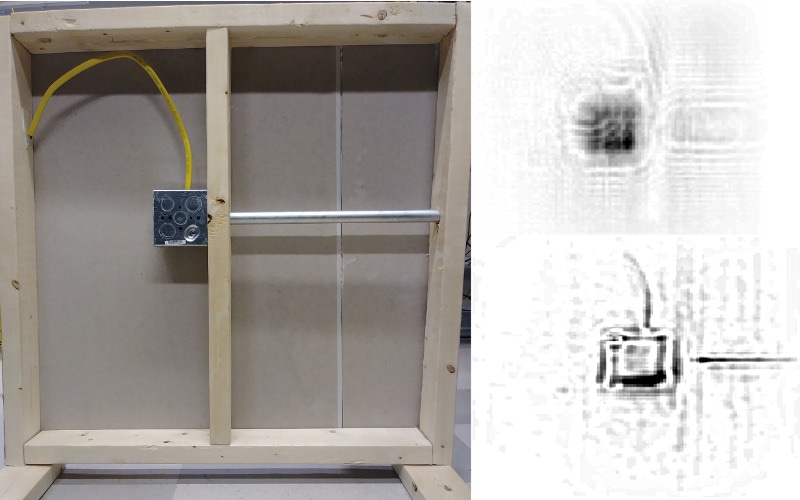Dec 7 2017
Duke University Researchers have now devised a way to see through walls with the help of a narrow band of microwave frequencies without any advance knowledge of what the walls are developed from. The approach, besides having noticeable applications in the realm of security, is also capable of leading to cost-effective devices in order to help construction workers effortlessly locate conduits, wires and pipes.
 A view of a microwave scan of a typical wall interior before and after distortions have been removed. By taking into account the types of distortions typically created by flat, uniform walls, the new algorithm allows for better scans without needing to know what the wall is made of beforehand. CREDIT: Daniel Marks, Duke University
A view of a microwave scan of a typical wall interior before and after distortions have been removed. By taking into account the types of distortions typically created by flat, uniform walls, the new algorithm allows for better scans without needing to know what the wall is made of beforehand. CREDIT: Daniel Marks, Duke University
The study has been featured in the December 5th, 2017, issue of the journal Optica.
Most technologies that can see through walls use a broad range of frequencies, which makes them expensive. They also don’t have very good resolution. So while they might be fine for seeing a person moving on the other side of a wall, they’re terrible for finding thin conduits or wires.
Daniel Marks, Associate Research Professor of Electrical and Computer Engineering, Duke University
Existing approaches also typically depend on understanding what material the wall is made from before trying to see through the wall. This enables the software to predict how the wall will impact the scanning waves so that it can separate the distortions and echoes from the solid objects being sought.
In the new paper, Marks and his colleagues David R. Smith, the James B. Duke Professor of Electrical and Computer Engineering, and Okan Yurduseven, a postdoctoral researcher in electrical and computer engineering at Duke, have instead taken advantage of a wall’s symmetry.
Walls are normally uniform and flat in all directions, and because of this they distort waves in a symmetrical fashion. The newly explained technology employs this symmetry to its advantage.
We wrote an algorithm that separates the data into parts—one that shows circular symmetry and another that doesn’t. The data that doesn’t have any symmetry is what we’re trying to see.
Okan Yurduseven, Postdoctoral Researcher, Electrical and Computer Engineering, Duke University
The technique employs only a single frequency to scan since it cuts down on the number of interference patterns developed by the wall and single-frequency emitters are indeed much less expensive when compared to the broadband emitters. Sticking to a narrow range also explains the fact that a future device would be easier to clear with the Federal Communications Commission (FCC), as it would be easy to evade interfering with microwave frequencies dedicated to various other technologies, such as Wifi, Bluetooth and cellular phone service.
The researchers created a prototype device to observe how well it would function. In their laboratory, they developed a couple of varied types of walls and then positioned objects behind them. These are objects that a worker might want to discover, such as studs, wires, electrical conduits and junction boxes.
Observing the raw data after scanning via gypsum plasterboard, it is tough to make out anything other than a metal junction box, which is two inches thick and four inches wide. However, after examining the data and then removing the symmetrical patterns, the pictures clear considerably, and every single component is effortlessly recognized.
We envision combining this technique with a machine vision system that someone could move over a wall to see what’s inside. We think the technology has the price point and sensitivity to make an impact on the market.
Daniel Marks
The Air Force Office of Scientific Research (FA9550-12-1-0491) supported this work.